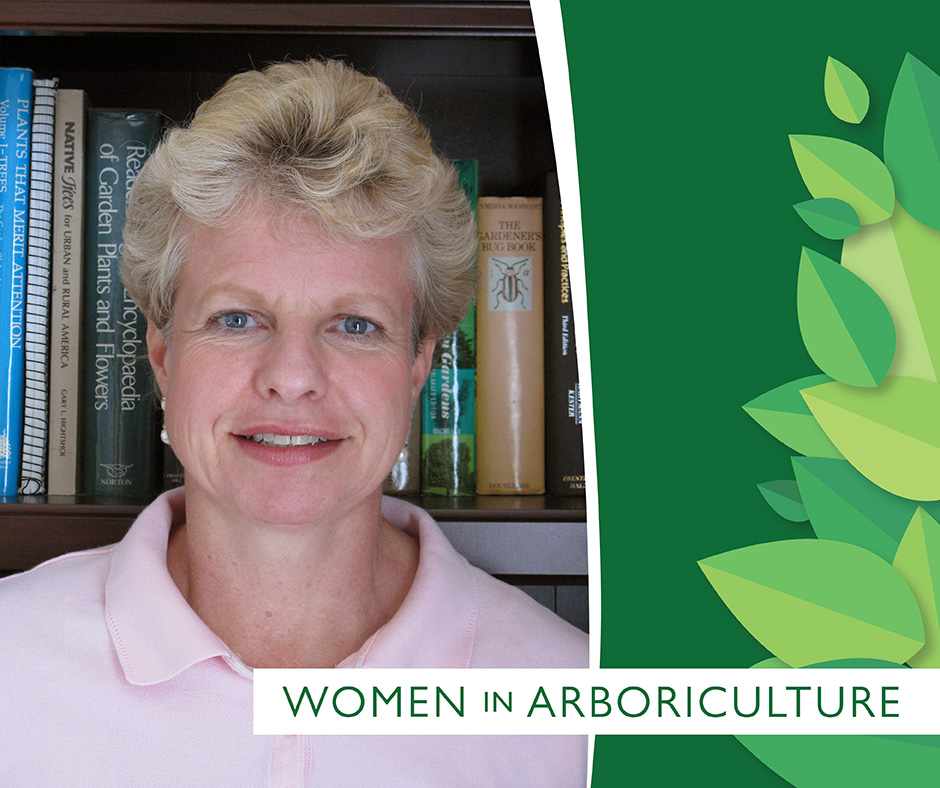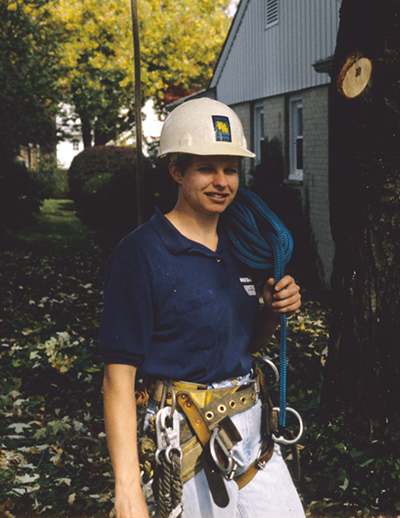I just wanted to be an arborist
Like many arborists, Sharon Lilly’s arboriculture journey began with a passion for climbing. “I loved to climb,” she said. “I was a bit of an adrenaline junkie and I loved being in the trees. It fueled my soul.”
Lilly began working with trees while in high school on weekends, breaks and summers. Her work with trees eventually extended in to her college years where she worked as a part-time climber, but it wasn’t until she took a break after studying pre-med for two years that she decided to make it a career.
 “I felt like I was just existing through each week, waiting for Saturdays when I could get back in the trees,” she said. “Feeling miserable, I took a year off to work, then I switched to horticulture when I returned to school. I never looked back.”
“I felt like I was just existing through each week, waiting for Saturdays when I could get back in the trees,” she said. “Feeling miserable, I took a year off to work, then I switched to horticulture when I returned to school. I never looked back.”
For the first 25 years of her career, Lilly predominantly worked in the commercial arboriculture field. “I also did some sales and consulting, but never particularly enjoyed it as much as the physical work,” she said. At the same time, however, Lilly was very active in ISA, where she began working mostly on the development of certification.
“Certification has obviously had a profound influence on the arboriculture profession,” she said. “It provided the impetus for tens of thousands to expand their knowledge and improve their professionalism. It created a need and a thirst for educational products and programming. It helped make our profession acknowledged and respected among other professions. It has gradually made the title ‘arborist’ part of the public vocabulary. And, for many individuals, attaining arborist certification—or later [ISA Board Certified Master Arborist®]—has been a highlight of their professional careers.”
Additionally, her work with ISA led to Lilly pursuing her other passion—education.
“Working at ISA provided the opportunity to create education and training materials that hundreds of thousands of arborists would use. ISA was in a position to lead the way with science‐based books, courses and programming, and cutting‐edge training videos, podcasts and online courses that emphasized safety at every level.”
It was Lilly’s love for education that led to her authoring several popular books, including the “ISA Arborists Certification Study Guide,” “The Tree Climbers’ Guide,” “The Tree Worker’s Manual” and “Managing Golf Course Trees” as well as countless articles, manuals, workbooks and other publications. Additionally, Lilly led the development of the “Tree Risk Assessment Manual and Qualifications,” as well as the “Best Management Practices for Tree Risk Assessment.”
 “The development of [the Tree Risk Assessment Qualification (TRAQ)] was a rewarding process,” she said. “We had a terrific team, both at the volunteer and staff levels. TRAQ (and the Tree Risk Assessment BMP) changed the way arborists approach tree risk assessment. Moreover, the program established a very strong model for the development of future qualifications.”
“The development of [the Tree Risk Assessment Qualification (TRAQ)] was a rewarding process,” she said. “We had a terrific team, both at the volunteer and staff levels. TRAQ (and the Tree Risk Assessment BMP) changed the way arborists approach tree risk assessment. Moreover, the program established a very strong model for the development of future qualifications.”
It was in 1997 when Lilly became the first female president of ISA. Lilly remembers her presidency as a time when ISA was beginning to work to become truly international. Arborist certification was attracting interest in both Europe and Asia, which was putting the organization on the radar. Additionally, she commented on how the chapters were beginning to reap the benefits of the certification program, which would lead to the viability of paid executive directors.
“I was elected president of ISA way back when the general membership elected the president and the Board of Directors was more than 50 people,” she said. “Not only was I the first woman president, I was also the youngest. I am honored to hold those distinctions, but I am prouder to see the number of women involved in the profession today, and many of them emerging as leaders.”
Although the number of women involved in the profession is increasing, Lilly said she believes focusing on recruitment and retention will help grow the industry. “When we manage to recruit women to the profession, we need to avoid demotivating them with hurdles and challenges that men don’t face,” she said. “We need to provide encouragement and illuminate pathways for career advancement.”
Even though she helped pave the way for many female arborists, Lilly said she never wanted to be seen that way.
“I never wanted to be a ‘female arborist.’ I just wanted to be an arborist. I think that the vast majority of men in the industry have welcomed women and have treated them with respect. Sadly, there have been exceptions, and there have been times when I and other women have had to persevere through difficult times. Even though the profession is still mostly male—by a large percentage—I believe we are finally getting to a point where we don’t think female arborists are unusual, except in field production work. I think that there will come a time that a reference to an arborist does not necessarily connote a man.”
Check out the other Women in Arboriculture profiles.